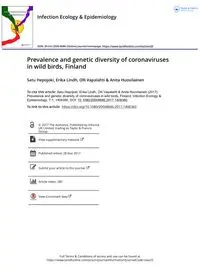
2017 Prevalence and genetic diversity of coronaviruses in wild birds, Finland PDF
Preview 2017 Prevalence and genetic diversity of coronaviruses in wild birds, Finland
Full Terms & Conditions of access and use can be found at https://www.tandfonline.com/action/journalInformation?journalCode=ziee20 Infection Ecology & Epidemiology ISSN: (Print) 2000-8686 (Online) Journal homepage: https://www.tandfonline.com/loi/ziee20 Prevalence and genetic diversity of coronaviruses in wild birds, Finland Satu Hepojoki, Erika Lindh, Olli Vapalahti & Anita Huovilainen To cite this article: Satu Hepojoki, Erika Lindh, Olli Vapalahti & Anita Huovilainen (2017) Prevalence and genetic diversity of coronaviruses in wild birds, Finland, Infection Ecology & Epidemiology, 7:1, 1408360, DOI: 10.1080/20008686.2017.1408360 To link to this article: https://doi.org/10.1080/20008686.2017.1408360 © 2017 The Author(s). Published by Informa UK Limited, trading as Taylor & Francis Group. View supplementary material Published online: 28 Nov 2017. Submit your article to this journal Article views: 280 View Crossmark data RESEARCH ARTICLE Prevalence and genetic diversity of coronaviruses in wild birds, Finland Satu Hepojokia*, Erika Lindha,b*, Olli Vapalahtia,b,c and Anita Huovilainend aVirology, University of Helsinki, Helsinki, Finland; bHelsinki University Hospital, Helsinki, Finland; cVeterinary Biosciences, University of Helsinki, Helsinki, Finland; dResearch and Laboratory Department, Veterinary Virology, Finnish Food Safety Authority, Evira, Helsinki, Finland ABSTRACT Introduction: Migratory birds act as hosts for a number of zoonotic viruses, and have the ability to disperse these viruses to distant geographic locations. Coronaviruses (CoVs) repre- sent a family of zoonotic viruses with wide variety of animal hosts, including birds and humans. The infections caused by coronaviruses vary from mild to severe, depending on the viral species and the host. Since the coronaviruses exhibit extraordinary large RNA genome, also the rate of homologous recombination is high, which in turn contributes to the genetic diversity and interspecies host-switches of CoVs. The emergence of novel CoVs has been rich during the last decades, and wild birds seem to serve as reservoirs for a variety of CoV strains. We examined the CoVs circulating among wild birds in Finland. Materials and methods: Samples (cloacal swab, tracheal swab, oropharyngeal swab, or tissue) representing 61 bird species were collected during 2010-2013, and examined by RT- PCR targeting the RdRp gene for the presence of CoV RNA. Results: Altogether 51/939 (5.4%) of the examined birds were found positive by RT-PCR. Diverse gamma- and deltacoronavirus sequences were detected. Discussion: Gamma- and deltacoronaviruses circulate among wild birds in Finland. The number of CoV-positive birds detected each year varies greatly. ARTICLE HISTORY Received 23 May 2017 Accepted 17 November 2017 KEYWORDS Deltacoronavirus; gammacoronavirus; wild birds; zoonoses Introduction Coronaviruses (CoVs) comprise a family under the order Nidovirales (family Coronaviridae) and infect a wide variety of mammals and birds. The course of infection varies greatly from asymptomatic to severe disease, depending on the host and virus species in question. The genome of CoVs is one of the largest (25–32 kb) viral RNA-genomes [1]. Based on phy- logenetic analysis, the CoVs are divided into four different genera: Alpha-, Beta-, Gamma-, and Deltacoronavirus. The alpha- and betacoronaviruses are carried by mammals, whereas the gamma- and deltacoronaviruses mainly infect birds, with few exceptions [2,3]. The large genomes, infidelity of the RNA-dependent RNA polymerase, and high fre- quency of homologous RNA recombination are the main factors contributing to the high genetic diver- sity of CoVs [4–6]. The first CoV, Infectious bronchitis virus (IBV), was identified in 1937 [7]. IBV mainly infects chick- ens, but may infect other bird species as well. IBV is highly contagious and affects the respiratory tract, gut, kidney, and reproductive systems, causing sub- stantial economic losses in the poultry industry [8]. Despite the global distribution of IBV, poultry in Finland remained free of clinical cases until April 2011 [9] after which outbreaks involving several CoV genotypes have occurred in Southern Finland. The first human CoVs were identified in 1960s [10– 12]. The human CoVs cause generally mild to moder- ate upper respiratory tract infections [13–15]. In 2003, a novel highly pathogenic betacoronavirus emerged in China, causing severe disease characterized by acute respiratory distress and it became known as severe acute respiratory syndrome (SARS)-CoV. The emer- gence of SARS-CoV [16] inspired virologists to more explore the highly divergent group of coronaviruses and their hosts, leading to the identification of a rapidly growing number of CoV species particularly in bats [2]. More recently, another highly pathogenic betaCoV infecting humans, the Middle East Respiratory Syndrome (MERS) CoV emerged in 2012 with a case fatality rate of over 40% [17,18]. Migratory birds have the ability to facilitate the dispersion of microorganisms with zoonotic poten- tial. Wild birds have been associated with the ecology and dispersal of at least West Nile virus, tick-borne encephalitis virus, influenza A virus (IAV) and Newcastle disease virus (NDV) [19–21]. Since the discovery of IBV in 1937, it remained the only CONTACT Satu Hepojoki
